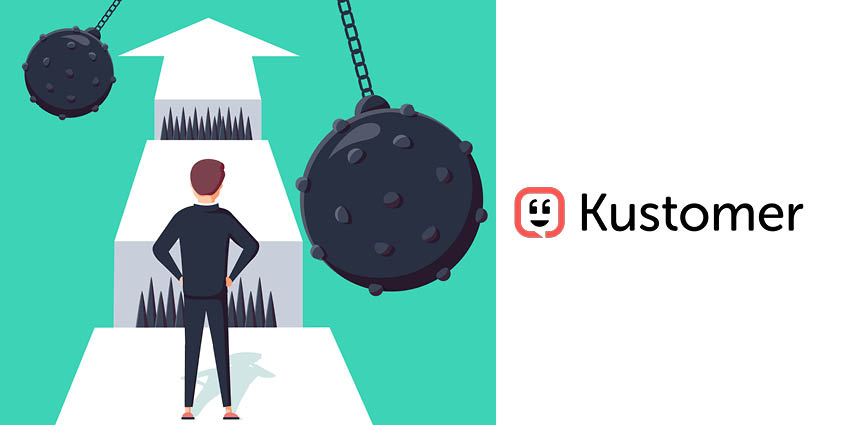New research from leading CRM provider Kustomer reveals the most prevalent challenges CX professionals want to overcome before 2025.
After surveying over 100 industry specialists for its “What the Future Holds for CX Organizations” report, Kustomer uncovered the following issues as the most widespread:
- Customers need to repeat information (46%)
- Lack of personalization in customer interactions (34%)
- Customers’ perception that their time is not valued (34%)
- Agents lack context about customers (30%)
- Customer service being siloed from other departments (30%)
Fortunately, as the report states, “Our biggest challenges are also our biggest opportunities.” Indeed, getting to grips with where they are falling behind often opens up the most fruitful investment opportunities for businesses.
So, if the issues above appear a little too familiar, here is some helpful advice to pave a path forward to a happier 2025.
1. Customers’ Need to Repeat Information
Whether a customer shifts from email to voice, a bot to a human, or perhaps from one agent to another – on the same channel – they must frequently repeat themselves. Not only is this frustrating for the customer, but it also wastes time for agents.
Omnichannel promised to put an end to this problem. Yet, it persists. Siloed data and legacy CRM systems are often to blame, failing to provide contact center agents with the necessary customer context to continue a conversation. Instead, it starts from scratch.
Luckily, the cloud enables contact centers to upgrade their CRM easily, integrate it into the technology ecosystem, and start tracking each customer’s complete interaction history. As such, operations maintain context as customers switch between channels.
Thanks to this capability, agents know exactly who the customer is, their purchase history, and any previous or ongoing engagements. This paves the way for seamless contact center conversations while lowering effort for agents and customers.
2. Lack of Personalization in Customer Interactions
Instead of customer segmentation initiatives, brands are kickstarting hyper-personalization initiatives to become more strategic around individual customers. Such strategies – including pre-populating applications, dynamic pricing, and real-time product notifications – are transforming CX but heavily hinge on customer data.
Fortunately, many companies have created a central data lake to simplify the process. Connecting AI tools to this – or harnessing those available within the data platform or CRM – allows businesses to bolster their personalization efforts across the customer journey.
There are many such use cases that Gabe Larsen, Vice President of Marketing at Kustomer, puts forward with respect to customer service. He says:
“With the help of AI, a customer service agent can devote all their energy to personalizing the conversation, sympathizing with the customer, and resolving their issue. They can kick the nitty-gritty stuff, like returns and reorders, over to a machine.”
“These interventions save time for both customer and agent, increase time spent on the actual issue, boost agent productivity, and enhance customer service.”
Moving beyond reactive customer support, contact centers may also become more sophisticated with their proactive outreach. Indeed, they may get ahead of potential issues before customers are even aware of a problem, creating opportunities to build loyalty and generate sales.
3. Customers’ Perception That Their Time is Not Valued
Customer experience management (CXM) dedicates an entire field to isolating and removing frictions from customer journeys, which costs time and customer effort.
However, one pain point that persists is long queues to access customer support. Struggling to hire the staff to meet inbound demand, companies are becoming more innovative in dealing with this problem and lowering wait times.
Some methods, such as digital deflection, are risky. Yet, getting ahead of the game, anticipating contacts, and becoming more proactive is an approach gaining momentum. Indeed, 2022 Gartner research finds that receiving proactive service increases customer value by 9%.
Again, such a successful strategy will likely revolve around “a CRM platform that can power bulk messaging, targeting specific customer segments based on your unique data, like orders, location, or customer satisfaction,” according to Larsen.
Yet, contact centers can also harness the power of prediction in other ways to reduce wait times. For example, predictive analytics allows managers to enhance forecasts and staffing calculations, helping operations to better meet incoming demand.
4. Agents Lack Context About Customers
Similar to the first problem, contact centers can address this issue with a CRM-driven omnichannel solution that tracks the conversation history of customers across various channels.
However, exploiting additional analytics tools to present new insights, dig deeper into this data, and surface valuable customer information will further enhance the contact handling process.
Many of these tools are embedded into modern, sophisticated CRM systems. Take Kustomer as an example. It offers agents a timeline of the customer journey, including website visits, purchases, and customer sentiment history – alongside previous interactions.
The solution integrates with an array of enterprise software to enable these capabilities. For instance, it connects with the order management system, allowing all customers to purchase details to fit within the platform.
Discover more about how such a timeline looks by checking out the video below.
5. Customer Service Being Siloed from Other Departments
CX is slowly becoming more of a team sport, as service teams track persistent customer problems, identify the root cause, and pass them over to other departments, which may amend the issue.
An approach of this ilk is only logical, yet it often stagnates as contact centers struggle to expand their sphere of influence across the company. As such, operations must often create a business case with metrics, associated costs, and recordings of angry customers to get other department heads to take notice.
Yet, contact centers sometimes miss a trick by failing to make internal knowledge and qualitative feedback more readily available.
For instance, if customers may repeatedly write in asking for a product in a specific color or complain about the fit of a particular item. Gathering and sharing this information with the product team may inspire them to create a new color or add a size guide to the website.
Larsen shares this example before noting:
“If all of this is tracked and tagged in a centralized CRM, customer service agents can proactively reach back out to customers and let them know that they took action on their feedback, building trust and leading to business growth.”
Further ideas to break down barriers with other departments include appointing senior agents as CX liaisons, building a shared workspace, and actively promoting goodwill.
Eager to dig up more interesting findings from the Kustomer report? If so, you can download a copy here: What the Future Holds for CX Organizations







